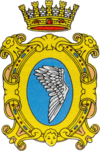Larino
| Larino | ||
|---|---|---|
| Comune | ||
| Comune di Larino | ||

Detail of the Cathedral's portal.
|
||
|
||
| Location of Larino in Italy | ||
| Coordinates: 41°48′N 14°55′E / 41.800°N 14.917°E | ||
| Country | Italy | |
| Region | Molise | |
| Province / Metropolitan city | Campobasso (CB) | |
| Government | ||
| • Mayor | Vincenzo Notarangelo | |
| Area | ||
| • Total | 88 km2 (34 sq mi) | |
| Elevation | 341 m (1,119 ft) | |
| Population (30 September 2012) | ||
| • Total | 7,087 | |
| • Density | 81/km2 (210/sq mi) | |
| Demonym(s) | Larinesi | |
| Time zone | CET (UTC+1) | |
| • Summer (DST) | CEST (UTC+2) | |
| Postal code | 86035 | |
| Dialing code | 0874 | |
| Patron saint | San Pardo and San Primiano | |
| Saint day | May 26 | |
| Website | Official website | |
Larino (Latin: Larinum, Campobassan dialect: Larìne) is a town and comune of approximately 8,100 inhabitants in Molise, province of Campobasso, southern Italy. It is located in the fertile valley of the Biferno River.
The old town, seen from the mountains, is shaped like a bird's wing. The new town, called Piano San Leonardo, is built on a mountainside.
The city of Larino has been continuously inhabited for millennia. Originally settled by the Samnite and Frentani tribes of Southern Italy, the city came under the control of the Oscan civilization. In 217 BC, the Romans defeated Hannibal here, and it was later incorporated into the Roman Empire, where it was classified as a municipium, and added to the Secunda Regio (Apulia).
When Julius Caesar and Pompey the Great fought for the power in Rome, the latter is said to have joined two of his legions who were encamped at Larinum. Earlier the consul Claudius marched through Larinum on his way to attack the Carthaginian Hasdrubal. The city's name appears in the works of the ancient historians Livy and Pliny. An important senatus consultum restricting public performances by members of the Roman upper classes was found nearby.
The modern city was built in the 14th century, after the old one, about 1.5 km away, was destroyed in an earthquake after having repeatedly been sacked by the Saracens. The old Roman city of Larinum was situated along the main road to the South-East, which started on the coast in Histonium (Vasto), and ran from Larinum eastward to Sipontum. The main road also branched off at Larinum into a secondary road to Bovianum Vetus.
In 1656, a plague nearly wiped out the city. The 373 survivors were prepared to abandon the settlement, but through the vigorous efforts of then Bishop Giuseppe Catalano, they were convinced to stay, and the city grew and thrived once again.
...
Wikipedia


